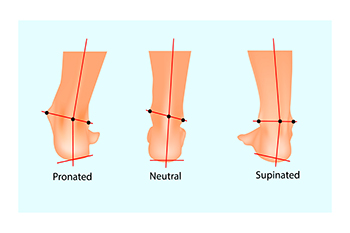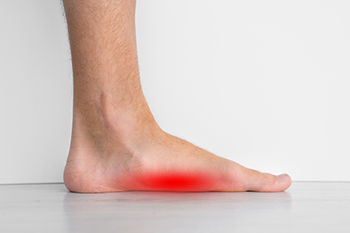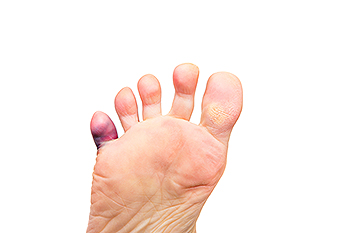Items filtered by date: January 2024
Facts About Pronation of the Feet

Understanding the intricacies of pronation is essential for runners, as it significantly influences shock absorption and the efficiency of push-off during each stride. Pronation, which is simply the natural side-to-side movement of the foot, comes in three main types. Normal or neutral pronation, where the foot rolls naturally inward by approximately15 percent, ensures proper shock absorption and alignment of ankles and legs. Underpronation, or supination, occurs when the foot rolls outward. This is more common among people with higher arches and can lead to injuries like Achilles tendonitis and shin splints. Overpronation involves excessive inward or downward rolling of the foot and is often associated with flat feet. Determining your pronation type is helpful for selecting appropriate footwear, but more importantly, this knowledge can minimize the risk of injuries. A podiatrist can analyze your gait and determine which type of pronation you have, factors that can result in an injury-free and a more enjoyable running experience. For a full assessment, it is suggested that you schedule an appointment with a podiatrist.
If you have any concerns about your feet, contact one of our podiatrist from North Texas Podiatry Associates. Our doctors can provide the care you need to keep you pain-free and on your feet.
Biomechanics in Podiatry
Podiatric biomechanics is a particular sector of specialty podiatry with licensed practitioners who are trained to diagnose and treat conditions affecting the foot, ankle and lower leg. Biomechanics deals with the forces that act against the body, causing an interference with the biological structures. It focuses on the movement of the ankle, the foot and the forces that interact with them.
A History of Biomechanics
- Biomechanics dates back to the BC era in Egypt where evidence of professional foot care has been recorded.
- In 1974, biomechanics gained a higher profile from the studies of Merton Root, who claimed that by changing or controlling the forces between the ankle and the foot, corrections or conditions could be implemented to gain strength and coordination in the area.
Modern technological improvements are based on past theories and therapeutic processes that provide a better understanding of podiatric concepts for biomechanics. Computers can provide accurate information about the forces and patterns of the feet and lower legs.
Understanding biomechanics of the feet can help improve and eliminate pain, stopping further stress to the foot.
If you have any questions please feel free to contact our offices located in Euless and Southlake, TX . We offer the newest diagnostic and treatment technologies for all your foot and ankle needs.
Are Bunions Affecting Your Everyday Life?
Strengthening Exercises for Improved Arch Support

Flat feet, or pes planus, can benefit from targeted exercises that aim to strengthen the muscles surrounding the arches. Toe curls, a simple yet effective exercise, involve gripping a towel with your toes and lifting it off the ground. This helps engage the muscles along the arch and promotes better support. Arch lifts, where you lift the inner edge of your foot while keeping the outer edge on the ground, target the muscles responsible for maintaining the foot's arch structure. Heel cord stretches alleviate tension in the Achilles tendon and calf muscles, supporting overall foot flexibility. Additionally, ankle circles, rotating your ankles in both directions, enhance mobility and contribute to improved arch function. Incorporating these exercises into your routine gradually can contribute to the development of stronger foot muscles, providing better arch support and potentially aiding in the correction of flat feet over time. Consistency is key as you work toward building strength and stability in the intricate network of muscles that shape the foundation of your feet. If you have flat feet, it is suggested that you confer with a podiatrist who can offer you effective stretches and other relief techniques.
Flatfoot is a condition many people suffer from. If you have flat feet, contact one of our podiatrist from North Texas Podiatry Associates. Our doctors will treat your foot and ankle needs.
What Are Flat Feet?
Flatfoot is a condition in which the arch of the foot is depressed and the sole of the foot is almost completely in contact with the ground. About 20-30% of the population generally has flat feet because their arches never formed during growth.
Conditions & Problems:
Having flat feet makes it difficult to run or walk because of the stress placed on the ankles.
Alignment – The general alignment of your legs can be disrupted, because the ankles move inward which can cause major discomfort.
Knees – If you have complications with your knees, flat feet can be a contributor to arthritis in that area.
Symptoms
- Pain around the heel or arch area
- Trouble standing on the tip toe
- Swelling around the inside of the ankle
- Flat look to one or both feet
- Having your shoes feel uneven when worn
Treatment
If you are experiencing pain and stress on the foot you may weaken the posterior tibial tendon, which runs around the inside of the ankle.
If you have any questions please feel free to contact our offices located in Euless and Southlake, TX . We offer the newest diagnostic and treatment technologies for all your foot and ankle needs.
Inversion and Eversion Ankle Sprains

Ankle sprains, a common injury, often result from the foot turning inward, causing pain, swelling, and tenderness, primarily in the outer ankle area. Diagnosis involves clinical evaluation and sometimes X-rays. Treatment for mild sprains includes protection, rest, compression, and elevation along with early weight bearing. Moderate to severe sprains may require immobilization, and severe cases may need surgery. Inversion injuries typically involve the foot turning inward. It can cause tears in the outer ligaments, beginning with the one in front called the anterior talofibular. Conversely, eversion injuries occur when the foot turns outward, and may result in fractures of the inner ankle bone or ligament injuries. Recurrent sprains can increase the risk of future injuries. Clinical evaluation primarily diagnoses ankle sprains, and stress testing helps assess ligament integrity. X-rays are performed if fractures are suspected. If you feel you have sprained your ankle, it is suggested that you schedule an appointment with a podiatrist for a proper diagnosis and treatment.
Ankle sprains are common but need immediate attention. If you need your feet checked, contact one of our podiatrist from North Texas Podiatry Associates. Our doctors can provide the care you need to keep you pain-free and on your feet.
How Does an Ankle Sprain Occur?
Ankle sprains take place when the ligaments in your ankle are torn or stretched beyond their limits. There are multiple ways that the ankle can become injured, including twisting or rolling over onto your ankle, putting undue stress on it, or causing trauma to the ankle itself.
What Are the Symptoms?
- Mild to moderate bruising
- Limited mobility
- Swelling
- Discoloration of the skin (depending on severity)
Preventing a Sprain
- Wearing appropriate shoes for the occasion
- Stretching before exercises and sports
- Knowing your limits
Treatment of a Sprain
Treatment of a sprain depends on the severity. Many times, people are told to rest and remain off their feet completely, while others are given an air cast. If the sprain is very severe, surgery may be required.
If you have suffered an ankle sprain previously, you may want to consider additional support such as a brace and regular exercises to strengthen the ankle.
If you have any questions please feel free to contact our offices located in Euless and Southlake, TX . We offer the newest diagnostic and treatment technologies for all your foot and ankle needs.
Symptoms of a Broken Toe

Recognizing the symptoms of a broken toe is vital for prompt and effective treatment. The most common indicator is intense pain at the site of injury, often exacerbated by movement or pressure. Swelling and bruising typically accompany the pain, making the affected toe visibly discolored and tender to the touch. Limited range of motion is another hallmark sign, as the injured toe may resist normal movement or cause discomfort when attempting to flex or extend. In some cases, a broken toe may lead to deformity, with the toe appearing misaligned or out of place. Individuals may also experience difficulty walking or bearing weight on the injured foot. While pain and swelling may subside initially, persistent discomfort and difficulty moving the toe are red flags that warrant immediate attention. If you have the above symptoms, it is suggested that you confer with a podiatrist who can determine what the best treatment is for you.
A broken toe can be very painful and lead to complications if not properly fixed. If you have any concerns about your feet, contact one of our podiatrist from North Texas Podiatry Associates. Our doctors will treat your foot and ankle needs.
What to Know About a Broken Toe
Although most people try to avoid foot trauma such as banging, stubbing, or dropping heavy objects on their feet, the unfortunate fact is that it is a common occurrence. Given the fact that toes are positioned in front of the feet, they typically sustain the brunt of such trauma. When trauma occurs to a toe, the result can be a painful break (fracture).
Symptoms of a Broken Toe
- Throbbing pain
- Swelling
- Bruising on the skin and toenail
- The inability to move the toe
- Toe appears crooked or disfigured
- Tingling or numbness in the toe
Generally, it is best to stay off of the injured toe with the affected foot elevated.
Severe toe fractures may be treated with a splint, cast, and in some cases, minor surgery. Due to its position and the pressure it endures with daily activity, future complications can occur if the big toe is not properly treated.
If you have any questions please feel free to contact our offices located in Euless and Southlake, TX . We offer the newest diagnostic and treatment technologies for all your foot and ankle needs.
Navigating Walking and Running Shoes

Embarking on a journey of fitness or leisure requires thoughtful consideration of the right footwear, and understanding the differences between walking and running shoes is pivotal. Walking shoes, designed for a heel to toe rolling motion, prioritize flexibility and stability. Their soles are crafted to absorb shock during the natural heel-strike phase of walking. Conversely, running shoes cater to a more dynamic gait, with features such as enhanced cushioning and support for the midsole and forefront. The structure of running shoes accommodates the impact and propulsion associated with a runner's stride. Recognizing these distinctions ensures that you provide your feet with the appropriate support for the activity at hand. Whether you are strolling through the park or pounding the pavement during a jog, investing in the right footwear not only optimizes performance but also safeguards against potential discomfort or injury, For guidance in choosing the proper walking and running shoes, it is suggested that you schedule an appointment with a podiatrist.
For more information about walking shoes versus running shoes, consult with one of our podiatrist from North Texas Podiatry Associates. Our doctors can measure your feet to determine what your needs are and help you find an appropriate pair of footwear.
Foot Health: The Differences between Walking & Running Shoes
There are great ways to stay in shape: running and walking are two great exercises to a healthy lifestyle. It is important to know that running shoes and walking shoes are not interchangeable. There is a key difference on how the feet hit the ground when someone is running or walking. This is why one should be aware that a shoe is designed differently for each activity.
You may be asking yourself what the real differences are between walking and running shoes and the answers may shock you.
Differences
Walking doesn’t involve as much stress or impact on the feet as running does. However, this doesn’t mean that you should be any less prepared. When you’re walking, you land on your heels and have your foot roll forward. This rolling motion requires additional support to the feet.
Flexibility – Walking shoes are designed to have soft, flexible soles. This allows the walker to push off easily with each step.
If you have any questions, please feel free to contact our offices located in Euless and Southlake, TX . We offer the newest diagnostic and treatment technologies for all your foot care needs.

